

 |
||
 |
||
Vol. 6 (2): December 2003 |
Download this page
|
|
Greece / Italy / Madeira / Mauritania & Western Sahara / Turkey
Italy
|
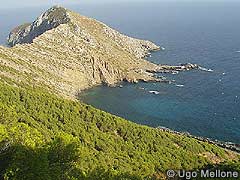 |
|
|
Marettimo. |
The island of Marettimo is still so beautiful. Like being in another dimension. Reach of colours, perfumes, pine forests, only one village, no houses scattered about, an enchanting, so transparent sea, and many marine caves… The ideal habitat for monk seals, which lived here until the end of the 70s, but were so heavily persecuted by the local fishermen and tragically exterminated, as in many other parts of the Mediterranean.
Here in Marettimo some GFM members set ashore last October, after the nowadays crowded summer season, thanks to the courtesy and kind hospitality of Franco De Salvo, a journalist very active on the island, who invited us to check today’s situation, after some rumours of recent seal sightings. Unfortunately the week devoted to our visit was, where weather conditions were concerned, the worst for many months, with rain and thunderstorms, so we were unable to start a planned survey of at least some of the caves as potential refuges for pilgrim seals… But we discovered something quite precious: the interesting reality of the local people, including the majority of the fishermen, now feeling sorry that their seals can no longer be found around the island anymore.
We were coddled by the former mayor, Vito Vaccaro, State Forestry Guard, the founder of an active local association which, among other aims, wants to protect the island environment… And some nice, if naïve, inhabitants wanted to know if it was possible for us “to import” some monk seal specimens and put them back in the island waters… while the new mayor wanted our reaction to his idea of placing a statue of the marine mammal in the old port as a commemoration of its presence in the past, with the hope of a “return” in the future…
Our group of experts had the chance to visit only four caves out of many opening along the Marettimo western coast, a lot of them under strong tourism pressure during the summer season, but peaceful during the rest of the year. Two were quite interesting from a… seal point of view, one being historically quoted as the most frequented by the Monachus… Which brings us, with some dramatic force, to a historical report by Pietrino Duran, which encapsulates some of the incredible nonsense that typified the human relationship with monk seals living around the island (this account, published in a small magazine, we discovered preserved in archives of the Vito Vaccaro’s active local cultural association):
“1st July 1901: for many days fishermen have been pointing out the presence of a large seal [Phoca vitulina, sic!] inside the picturesque cave of the Camel, near the old castle of Punta Troia. One evening, at nightfall, I decided to capture the huge pinniped. We prepared a small boat, piloted by the fisherman Pietro Spataro and by the young Nicolò Maiorana, and we weighed anchor in the company of two dear friends… We armed from head to foot, also providing ourselves with a good quantity of ball cartridges and taking with us, for any eventuality, also a lamp… and then we went to visit… the beloved guest.
As soon as we entered the cave, and not too far from its entrance, we heard the animal’s tremendous snoring, like the noise of an electric saw… The mammal was deeply sleeping!
We arranged the lamp so that its light was projected in front, so as to afford the best aim… Avoiding any noise or rustle that could awake the mammal, we entered and closed in with our guns levelled.
As we got nearer, and the seal appeared clearly, sleeping on the shore, I ordered my two friends to instantaneously open fire. Three simultaneous shots fired, and the poor animal was struck down because my sixteen-gauge ball had penetrated its heart, whilst the others’ twelve-gauge had penetrated its back.
We flung ourselves upon the seal with the intention to catch it and put it inside the boat, but its weight was excessive, the boat very small, and already overburdened with our own load… so it was necessary to tow the pinniped to the village tied up with a strong rope… We photographed the animal, and we weighed it: 350 kg! We then skinned it: underneath, a thick layer of fat, for more than 100 kg of oil… We threw the carcass into the sea… The skin, opportunely tanned, decorates today my dearest friend Totò Leone’s sitting-room… And still today, in the clean waters of the ‘Camel’ cave, seals find their shelter and we hope, on the first favourable occasion, to repeat this exciting hunt…”
The ‘Camel’ cave is there, with its beautiful shores inside, but today – during summer season at least -– it is visited only by fishermen’s boats carrying noisy tourists… And the shadows of their old inhabitants, with all their memories, silently slide away during the darkest winter nights…
Reference
Duran, Pietrino. 1928. Le Grotte – Giro dell’isola in barca. Una perla in fondo al mare: 22.
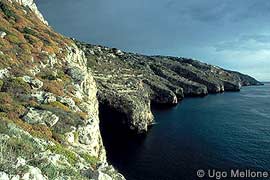 |
|
|
The coast near Santa Maria di Leuca. |
Following the monk seal sighting reported by a speargun fisherman in April 2003 along the coast of the Salento peninsula in Apulia [see Another seal sighting in Puglia, TMG 6 (1): June 2003], the location was inspected by GFM so as to verify the presence of suitable monk seal cave habitat.
The survey was also carried out to test the feasibility of deploying an infrared sensor capable of detecting a mammalian body. Unfortunately, the “cave” found at the location of the sighting was not considered of interest for the species. An infrared sensor was therefore placed further south of the sighting location, in a cave in which monk seals were sighted until the middle of the 1970s. It is hoped that future surveys may be conducted to identify suitable monk seal caves between Otranto and Santa Maria di Leuca. – Ugo Mellone, Emanuele Coppola, Luigi Guarrera, Gruppo Foca Monaca.
So far this breeding season, a single monk seal pup has been recorded on the Desertas Islands, reports Rosa Pires of the Parque Natural da Madeira. The first observations saw the pup using an open beach in the company of several other adults – behaviour that may suggest that the population is losing its fear of persecution as a result of stringent protection measures in force in the area [see Saving seals at Madeira… a passionate affair, this issue, and Beach life, Desertas-style, TMG 5 (1): May 2002]. “Although we have only one birth so far,” writes Rosa, “it was amazing to see three different females taking care of the same pup.”
On the main island of Madeira, meanwhile, sightings of seals continue and PNM researchers believe that at least one seal is regularly using its coasts to haul out and rest. After a spate of recent interactions between Madeirans and seals – some beachgoers unfortunately risking injury because of inappropriate behaviour – PNM continues its educational outreach through talks and the media [see Sightings collected, advice dispensed on Madeira, TMG 6 (1): June 2003].
Further information
Parque Natural da Madeira. 2003. Help us to help the monk seal. English brochure and sighting register: 1-2. [![]() 1.3MB]
1.3MB]
On 4 August 2003, an anchor problem resulted in the Moroccan bulk carrier Malika Tánger drifting until it finally ran aground at the beach of the Satellite Reserve of Cap Blanc, a protected area administratively connected to the National Park of Banc D’Arguin (PNBA).
A 118 meters long, the Malika Tánger is a bulk carrier of significant size that was empty at the time of the accident, its own fuel load posing the only danger of hydrocarbon pollution in the protected area.
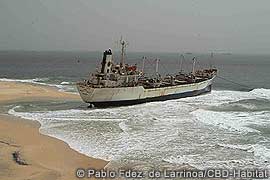 |
|
|
The bulk carrier Malika Tánger high and dry in the Satellite Reserve. |
The presence of the stranded ship is also provoking environmental disturbance of a different kind, as efforts are made to re-float her. The presence and activity of workmen and machinery in the area is inevitably upsetting the tranquility of this important refuge for marine birds and the few seals that still haul out here.
So far, the ship’s owner, in coordination with the PNBA, has been making great efforts to re-float her, but so far, without success.
The original aim of establishing this Satellite Reserve was the protection of the monk seals that hauled out on its beaches. Seals were abundant in this location in the past, although since the mass mortality that struck the Cabo Blanco colony in 1997, only two animals have continued to use the area. Despite this small number, the Reserve remains a key location for progressive re-colonization in the near future.
This accident reflects the fragile vulnerability of both the Satellite Reserve and the nearby monk seal colony to the intense maritime traffic that occurs around the Cap Blanc peninsula.
Moreover, maritime traffic involving transport of hydrocarbons will increase in the area in the near future when Mauritania begins the exploitation of its recently discovered marine oilfields. Bearing in mind the recent Prestige disaster in Spain, preventive measures would seem vital for this west African coast, not only one of the most productive fishing grounds in the area, but also home to the world’s largest surviving colony of Mediterranean monk seals and the rich biological diversity found at the vast National Park of Banc D’Arguin.
Measures that should be considered with urgency include banning single-hull oil tankers from near shore navigation, the classification of this coast as a sensitive marine area, and the development of emergency response plans – including providing countries with the means to implement those plans. – Miguel Angel Cedenilla & Pablo Fernández de Larrinoa, CBD-Habitat.
Since the start of regular marine surveillance in the “Coast of Seals” Reserve in December 2002 [see Improving surveillance of the Cabo Blanco monk seal colony, TMG 6 (1): 2003], setting of fishing nets in the area of the breeding caves has decreased significantly, and even disappeared during summer.
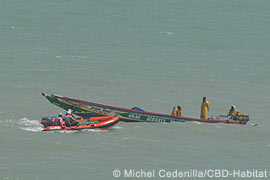 |
|
|
A surveillance patrol in the |
The region’s lobster fishery is exploited throughout the year, although a marked peak in its activity is seen between May and September – the season of highest abundance of green lobster, when many pirogues from other harbours come to the Cabo Blanco peninsula Atlantic Coast to fish. As to be expected, during this time, infractions increase in the “Coast of Seals” Reserve, usually due to the arriving fishermen’s lack of awareness about its existence.
Reacting to these pressures, marine surveillance becomes intensive during this period, and focuses on informing fishermen of the protection measures in force, and preventing them from setting nets in the reserve. During May and June, infractions peaked due to the constant arrival of many new fishing vessels, but the regular presence of the guards in the area resulted in infractions virtually disappearing at the end of June, with the incidence of set nets also approaching zero during the following months of August, September, October and November. – Pablo Fernández de Larrinoa & Miguel Angel Cedenilla, CBD-Habitat.
Within the framework of the social development work that forms part of the CBD-Habitat monk seal project in Mauritania [see Conservation actions on the Cabo Blanco peninsula – a new approach, TMG 5 (2): November 2002], this year, several actions were implemented with funds from the Spanish Ministry of Environment, the Spanish International Cooperation Agency, Fundación Biodiversidad and Euronatur.
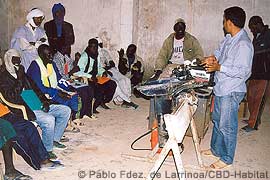 |
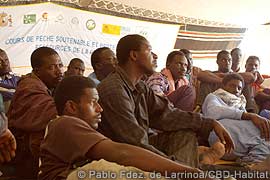 |
|
|
A course in outboard engine maintenance and repair. |
Artesanal fishers attending a course in sustainable fishing. |
Twenty-four births have so far been recorded during the current pupping season at the Cabo Blanco monk seal colony.
In contrast to previous years, where the maximum number of pups was produced in October, this year September ranked as the month with the highest number of births, even doubling those produced in October.
The pup mortality rate for this period (from June to date) has been 0.33, and no major changes are expected until the end of the breeding season in May 2004. This is an unusually low and welcome rate of mortality for pups, produced as a direct consequence of the displacement in birth months. Storms and high swells are common in winter months, usually beginning with a high frequency in October and coinciding with a time when most pups in the breeding caves are just a few days old. During the three previous years, the pup mortality rate has been 0.60, 0.48 and 0.44 respectively. This year, when the storm season began, most of the pups were old enough to have a better chance of survival in the caves.
Although the breeding season is not yet over and the information is still being processed, a very possible explanation for this displacement of the peak of parturitions could be the high pup mortality rate of the last breeding season (0.60). When a mother loses her pup and the lactation period is interrupted, the length of the period between births decreases. Because of the high number of mothers who lost their pups last year, these females might have given birth earlier, thereby producing the peak of births in September rather than October.
Despite annual variations like these, pup mortality remains high in the overall situation of the Cabo Blanco colony. – Miguel Angel Cedenilla & Pablo Fernández de Larrinoa, CBD-Habitat.
Mediterranean News continues with Turkey…
Copyright © 2003 The Monachus Guardian. All Rights Reserved |